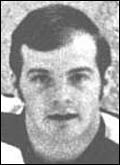Did the NHL Once Blackball American Players?
Researching the profile for former Colorado College and minor-league star Bob Collyard, a 1969 draft pick of the St. Louis Blues, I came upon an interesting story about a lawsuit that Collyard filed in a U.S. District Court during the late 1970s.
Collyard, who played 10 games with St. Louis in 1973-74 but never made it back to the NHL after that, sued the NHL, several U.S.-based teams, and even the United States government for effectively allowing the NHL and its clubs to discriminate against American hockey players. Another lawsuit filed by Warren “Butch” Williams attempted to make the same case, and the fact that these suits arose at the same time is noteworthy. Obviously, there was a sense among American players that they were not being given a fair shake in the NHL, which seemed far more interested in employing Canadians at the time.
Needless to say, Collyard vs. Washington Capitals and Williams vs. Boston Bruins didn’t get very far as court cases. In fact, they were both dismissed by a U.S. District Court in Minnesota on the same day. Legally, there was no grounds for a lawsuit, and it’s ridiculous to assume that there was an organized conspiracy against non-Canadian players.
No, this issue didn’t belong in a courtroom, but it is fair to say that it was very, very tough for American hockey players to reach the NHL in the 1970s. Many of the U.S.-born players from that era tell stories of being harassed by Canadians, who felt they were simply better at the sport. History has shown that USA Hockey can hold its own, and the potential discrimination long since faded away, but in the 1970s, it was probably very palpable.
Here’s what I wonder. Recall how violent hockey was in the 1970s. Recall that the product the NHL was selling was at least in part embraced because of that violence. Recall that Canadians were developed in leagues where fighting was tolerated, while Americans came up through high schools and colleges where fighting was strictly prohibited. Thus, there likely was a belief that the marginal American players were less inclined to cater to the rough stuff or drop the gloves. This might have made them less useful than their Canadian counterparts, even if they could skate and shoot the puck with more skill.
Again, not an organized conspiracy, but a reality of the era. Consider that the movie Slap Shot is widely recognized by hockey players of that era as coming very close to what life was like. At its heart, Slap Shot was a movie about a college player who didn’t fit into the pro lifestyle. Perhaps Boston-born Ned Dowd, the player on whose experience Slap Shot is based, felt a sense of discrimination from the Canadians of his day. Perhaps the Hanson Brothers — who are not just violent but crazy — are ironically shown the only Americans capable of fitting into such an environment, even though their hockey talent level is questionable at best.
Taking this issue to court was a bit much, but the mere existence of these cases is a reminder of what the NHL was like in the 1970s and reflect a very real sense within these players that they were not being given a chance because they came from south of the U.S.-Canadian border.

